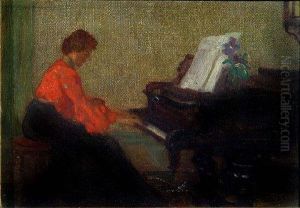Amelia Krauss-Pabst Paintings
Amelia Krauss-Pabst was a German artist known primarily for her work as a painter during the late 19th and early 20th centuries. Born on November 1, 1860, in Breslau, which was then part of Prussia (now Wrocław, Poland), Amelia showed an early talent for the arts. Her full name was Maria Emilie Louise Krauss, and she later added 'Pabst' to her surname after her marriage to the painter Paul Pabst.
Amelia's artistic journey began in earnest when she studied art in her hometown before furthering her education in Munich, a city that was, at the time, a vibrant center for artistic training and innovation. Munich provided her with exposure to new artistic movements and techniques, which she incorporated into her work. Krauss-Pabst was particularly influenced by the Munich School, known for its naturalistic and detailed approach to painting.
Throughout her career, Amelia Krauss-Pabst was recognized for her portraits and genre scenes. Her work was characterized by a delicate, sensitive touch and an ability to capture the essence of her subjects, often focusing on women and children in domestic settings. She had an adept use of light and shadow, which gave her paintings a soft and inviting atmosphere. Krauss-Pabst's art was well-received in her time, and she participated in several exhibitions, gaining a respectable reputation among her peers and art critics alike.
Despite her success, as with many female artists of the time, full recognition of her talents has only come with a greater appreciation for women’s contributions to art history in more recent years. Krauss-Pabst continued to paint throughout her life, remaining active in the arts until her death on October 14, 1935, in Munich, Germany.
Her legacy lives on through her paintings, which can be found in various private collections and occasionally in German museums. Amelia Krauss-Pabst's dedication to her craft and her position as one of the talented female painters of her era have cemented her place in the annals of art history.
